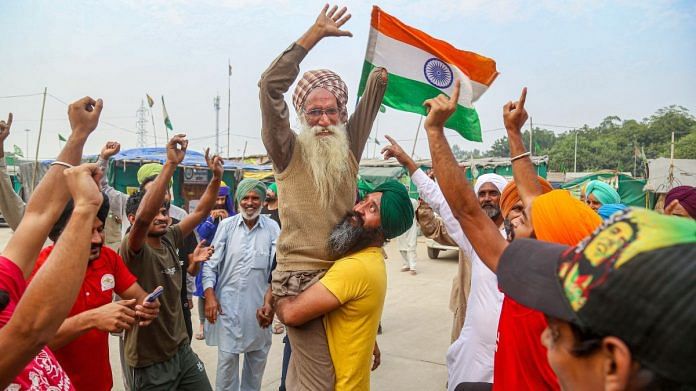The siege on Delhi-NCR border for the past one year by protesting farmers, a majority of whom came from Punjab, Haryana, and Uttar Pradesh, finally ended Thursday after the Narendra Modi government signed a letter accepting their demands.
In the history of democratic protests in India, it’s not often that a bunch of farmers have succeeded in bringing the Centre to its knees through their grit and perseverance. And they did it while keeping politicians out of their protest.
But nobody can deny the huge political ramifications of such an agitation. Wary of being seen as “anti-farmers” ahead of elections to four states and a Union territory early next year, including Uttar Pradesh that holds the key to the BJP’s chances of electoral success in 2024, the Modi government had to eventually climb down despite being firm on its stand earlier.
Prime Minister Modi, in an early morning address to the nation on 19 November, announced the repeal of the three farm laws. Subsequently, Parliament annulled the three laws during the ongoing Winter Session. Arguably, the farmers’ agitation had become the biggest headline in India for the last one year, drawing both domestic and global media attention. That is why, the end of the year-long farmers’ protest is ThePrint’s Newsmaker of the Week.
Also read: How farmer protest on Delhi borders ended: The 5 demands govt agreed to, and the 1 it didn’t
Capital siege
The agitation has once again highlighted how in India, no government can afford to annoy an important constituent like the farmers – even if that government has a massive mandate like the BJP-led National Democratic Alliance (NDA).
One can’t but draw parallel to another siege of the Capital by farmers over three decades back. That agitation, led by popular farm leader Mahendra Singh Tikait, culminated in a massive march of a few lakh farmers to Delhi’s Boat Club in 1988. Demanding, among other things, a waiver of their electricity and water charges, the farmers brought Lutyens’ Delhi to a grinding halt for two days.
Then too, the farmers forced the Congress government led by Rajiv Gandhi to eat crow and accept all their demands.
Also read: What farm laws retreat by Modi govt tells us about ruling India like a CM with brute majority
One-of-its-kind protest
From the siege of Red Fort to ‘toolkits’, pizza langar to foot massage – the farmers’ year-long protest was like no other in India.
The agitation started in Punjab in the last week of September 2020, after the Modi government passed the three farm laws. Sikh farmers squatted on rail tracks bringing train operations to a halt in the state.
Soon, the protest spread. Around October, farmers rode their tractors to block Delhi’s border at Singhu. It led to major traffic blockades at the border and there were clashes with the police too. But the farmers refused to budge.
Singhu became their second home. They started living inside their tractors, which were customised with washing machines, geysers, etc. Community kitchens were put up to feed the hundreds of farmers turning up every day. At night, some slept in tents, many others slept on the road, in or under their tractor.
There was a lot of bonhomie too. A pizza langar was set up, foot massagers and a salon sewa was also made available to make the protesters comfortable. All through this, the farmers’ focus did not waver.
Reverberations of the protest were felt elsewhere too. Disha Ravi, a 22-year-old environmentalist, was arrested for “disseminating” the ‘toolkit’ on farmers’ protest shared by Swedish climate change activist Greta Thunberg.
Delhi witnessed violent scenes on 26 January during a tractor rally to Red Fort after farmers hoisted the Nishan Sahib flag atop the heritage monument.
Also read: What did the farmers’ movement achieve? The original andolanjeevi, Gandhi, has an answer
Not all protests have succeeded in India
The farmers’ agitation was one of the few instances where the government had to eat humble pie.
Not all democratic protests in India have had a similar outcome though. The students’ protest over the V.P. Singh government’s decision to implement the Mandal Commission recommendation to reserve 27 per cent seats for OBCs in government services is an example.
V.P. Singh refused to go back on his decision, though his government fell after the BJP withdrew support.
Activist Medha Patkar-led Narmada Bachao Andolan against the construction of Sardar Sarovar dam on the Narmada River too could not force the government to stop work.
But it was a different story in Singur and Nandigram in West Bengal. The agitation over acquisition of land in the two villages not only forced the Tatas to move out their Nano car plant from Singur but eventually led to Mamata Banerjee’s ascension to power in the state after defeating the 30-year-old Left government.
But the farmers’ agitation, then and now, stand apart. Least because of the victory on both occasions.
Views are personal.
(Edited by Prashant)






